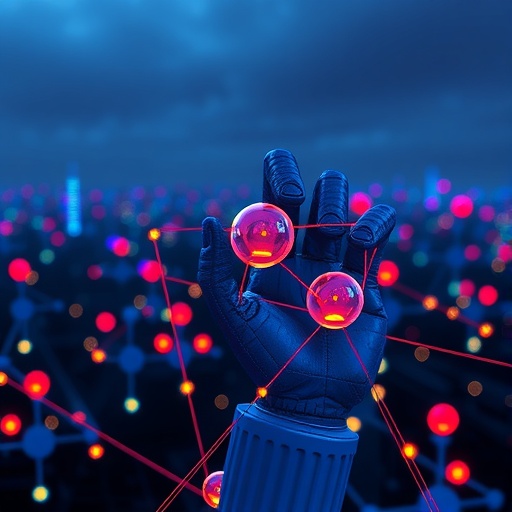In a groundbreaking study published in the journal “Discover Artificial Intelligence,” researchers Jiang, Wei, and Sun propose a novel method for optimizing communication in power networks through advanced machine learning techniques. The authors delve into the intricate workings of power network management, a field critical for the efficient functioning of modern energy systems. Power communication networks serve as the backbone for much of today’s infrastructure, relying on efficient data exchange to ensure stability and reliability in power distribution.
The study’s primary focus lies in addressing the inherent challenges associated with power network communication. Traditional methods often struggle with issues such as latency and network congestion, which can have dire consequences in critical situations like energy shortages or blackouts. By employing deep reinforcement learning (DRL), a subfield of machine learning that focuses on how software agents can take actions in an environment to maximize cumulative reward, the researchers aim to enhance the responsiveness and accuracy of power network communications.
The authors introduce the concept of Riskquant-grl, a self-optimal control method designed specifically for power networks. This approach represents a significant advancement over conventional optimization strategies by utilizing graph deep reinforcement learning. Graph-based models enable the representation of power systems as dynamic networks, where nodes symbolize power sources or consumers, and edges illustrate the communication pathways between them. This framework allows for a more nuanced understanding of the complexities involved in power distribution, providing a strategic advantage when making real-time operational decisions.
A core aspect of the study is the extensive experimentation the research team undertook to demonstrate the effectiveness of their proposed method. The authors meticulously crafted various scenarios to emulate real-world conditions, painstakingly adjusting parameters to reflect the uncertainty and variability present in power systems. This rigorous testing validates the robustness of the Riskquant-grl algorithm, showcasing its ability to enhance communication efficiency under varied operational stressors.
Notably, the authors emphasize the role that machine learning plays in advancing power network communication. With the increasing integration of renewable energy sources, such as wind and solar, traditional communication protocols are often ill-equipped to handle the complexities introduced by these new variables. Machine learning offers a promising solution, as it can dynamically adapt to changing conditions, thereby ensuring that power networks remain stable and functional even in highly variable environments.
The innovation inherent in this research holds broad implications not just for power networks but also for the future of smart grid technology. As we move towards more interconnected and intelligent energy systems, the ability to efficiently communicate and manage data will be paramount. The introduction of Riskquant-grl aligns with this vision, suggesting a future where power networks operate with unprecedented efficiency and adaptability.
Another significant contribution of this study is the detailed analysis of the computational needs associated with implementing deep reinforcement learning models in real-world scenarios. The authors provide insights into the hardware and software requirements for deploying their algorithm effectively, creating a valuable resource for practitioners in the field. This transparency fosters understanding and encourages the adoption of advanced machine learning techniques across various applications in energy management.
Moreover, the integration of Riskquant-grl within existing power systems could lead to a substantial reduction in operational costs. By optimizing communication pathways and minimizing latency, energy providers can enhance their service quality while reducing waste. This aspect could be particularly beneficial in regions grappling with aging infrastructure, where modernizing communication systems can yield significant returns on investment.
The implications of the findings are vast, extending beyond just the field of energy management. The principles underlying the Riskquant-grl methodology could be applied to other sectors facing similar communication challenges, such as telecommunications, transportation, and logistics. By demonstrating the potential of machine learning to transform traditional practices, the authors pave the way for interdisciplinary applications that could further enhance efficiency across various industries.
Moreover, the emphasis on self-optimal control within their framework reflects a growing trend in the use of AI-driven solutions for complex systems management. As real-world problems become increasingly multifaceted, the need for adaptive and autonomous systems becomes more pronounced. This research contributes to the discourse surrounding the future of artificial intelligence, particularly in its applicability to grounded, practical challenges faced by society today.
In conclusion, the study by Jiang and colleagues offers a compelling vision for the future of power network communication through the lens of graph deep reinforcement learning. The risks associated with power management demand innovative solutions, and their proposed approach not only meets this need but also exemplifies the potential of machine learning to enhance operational efficiencies. As the world transitions towards more sustainable energy systems, the findings of this research could play a pivotal role in ensuring that our power networks are robust, efficient, and prepared for the challenges of tomorrow.
This transformative research underscores the ongoing evolution of power distribution and communication technologies. By breaking down complex systems into manageable, data-driven approaches, researchers are unlocking new possibilities in the quest for enhanced energy management solutions. The widespread adoption of such methods may well be the linchpin for a new era in the energy sector, where intelligent systems seamlessly integrate to optimize performance across all facets of power distribution.
As the implications of this research unfold, the energy industry should prepare for an influx of innovative methodologies inspired by the breakthroughs outlined in this study. The seamless integration of machine learning and power communications, as illuminated by the Riskquant-grl framework, could redefine operational standards and expectations.
Subject of Research: Optimization of communication in power networks using graph deep reinforcement learning
Article Title: Riskquant-grl: a self-optimal control method for power network communication based on graph deep reinforcement learning.
Article References: Jiang, Y., Wei, Y., Sun, C. et al. Riskquant-grl: a self-optimal control method for power network communication based on graph deep reinforcement learning. Discov Artif Intell 5, 325 (2025). https://doi.org/10.1007/s44163-025-00587-0
Image Credits: AI Generated
DOI: https://doi.org/10.1007/s44163-025-00587-0
Keywords: Deep Reinforcement Learning, Power Networks, Communication Optimization, Graph Models, Smart Grids.




